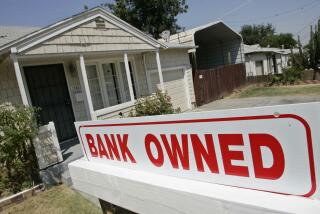Common loan modification programs
Banks can offer loan modifications or other programs if you’re behind -- or will soon be -- on a mortgage.
Often the changes involve easing up on the interest rate, at least temporarily, or changing the payment schedule to give you more breathing room. But banks generally will offer these programs only if you have good prospects for paying off the loan eventually.
The bank to which you write your mortgage check isn’t always calling the shots in these matters. In almost all cases that bank is paid merely to service the loan -- the real lender is a near-silent partner. The lender can limit modifications to ease payment burdens.
It’s a good idea to see a counselor certified by the Department of Housing and Urban Development -- at no charge -- to explore the kind of modifications the bank might accept in your case. Also, before you accept a bank deal that involves signing documents, you can have them reviewed at one of the agencies offering free legal advice.
The common programs include:
Forbearance
This is a temporary suspension of payments.
This sometimes is offered if a borrower has lost a job but has a new one starting in the near future. Or perhaps there was a temporary cash shortage because of medical bills or other matters.
A forbearance usually lasts just a few months. Then the bank wants payments to resume and the missed payments made up.
Repayment plan
This is a blueprint for making up missed payments, usually over time.
For example, if your mortgage payment is $2,000 a month and you miss three months to put you $6,000 in arrears, a repayment plan might allow you to make up the missed payments over a year. In that case, the minimum monthly payment would be $2,500 for a year.
Modification
This is a change in loan terms to the consumer’s benefit.
Some subprime loans start out at an affordable interest rate and then, like a time bomb, burst upward to the point that the monthly payment as much as doubles.
If the homeowner can’t make the payments at the higher rate, the lender might lower the interest rate for a limited time.
For example, if your rate jumped to 8%, the bank might consider lowering it to 6% or less for the next five years. In some cases, the modified rate starts especially low, then grows in steps during the modification period.
Modifications to principal -- the remaining balance on a loan -- are rarer than a happy subprime borrower.
Legal challenge
You can tell it to the judge.
This is one of the few ways to get the principal of the loan reduced, but it’s probably not going to happen without a fight. Such a reduction sometimes is granted by a court or in a settlement because something illegal happened during the lending process.
In some cases, the annual percentage rate -- better known as the APR -- wasn’t disclosed in subprime loans, perhaps because it was so appallingly high. Or some misrepresentation was made to the borrower.
Attorney Debra Zimmerman at Bet Tzedek Legal Services, a nonprofit that offers free legal help to mortgage holders in Los Angeles County, said that through challenges from her office, a $170,000 loan was reduced to $125,000 and a $439,000 loan went down to $340,000.
--
david.colker@latimes.com
More to Read
Inside the business of entertainment
The Wide Shot brings you news, analysis and insights on everything from streaming wars to production — and what it all means for the future.
You may occasionally receive promotional content from the Los Angeles Times.









